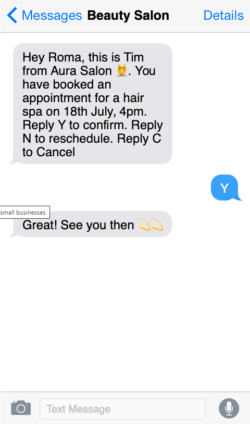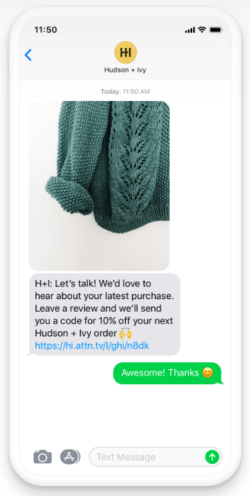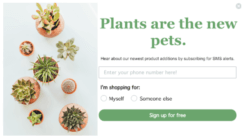The average customer is glued to their phone. In fact, on average, Americans check their phones 344 times a day — that’s once every 4 minutes! While we all need to maybe reevaluate our screen time, it’s evident that phone use is only becoming more pervasive. And with that, SMS marketing and customer service will only become more useful to businesses.
Today, customers are looking for fast and flexible service. They want to send a message and get an immediate answer to their questions. SMS messaging is one of the quickest ways to reach customers by pinging directly in their back pockets. SMS contributes to your marketing strategy as well. With SMS marketing, you can access customers and spread the word about new initiatives, product updates, and promos with a greater guarantee that your message will actually be seen.
To help you out along the way, we’ve pulled together a playbook for you with strategies for how SMS marketing and customer service can be used to support your customer experience.
SMS Customer Service Strategy
Good customer service is really the backbone of every brand. When your customer service is strong, your brand can build trust as you understand more and more what pain points and problems your customers face. Plus, when customers are happy, they keep coming back.
Great customer service increases retention rates, and a simple increase of just 5% in retention rates can lead to a 25% increase in profits. In our increasingly remote and flexible way of life, customers have grown accustomed to omnichannel service that meets them where they are. SMS offers just this.
Here are 3 SMS strategies you can use to support your customers:
1. Conversational customer support
One of the greatest advantages of SMS for customer service is that it allows for personal and casual conversations with your customers. Everyone who has a phone is used to texting. It’s an accessible way to reach anyone in your customer base who owns a phone — which is now 97% of the U.S. population.
Send customers messages to help them in real time through an issue. Add in media, like photos and videos, to guide customers step by step without the formality and the lapses in time experienced in email.
2. Scheduling, canceling, and altering appointments
This is a bit embarrassing, but I’ve got about 3 reminders on my phone at the moment to schedule or adjust upcoming doctors’ appointments. Every couple days, they pop up to remind me (yet again) that I need to call in to my doctor to make that appointment. And every couple days, I hit “Remind me tomorrow.” Why? Because I hate making phone calls. I would much rather send out a text to my dentist’s office to request an appointment, just like I do with my hair salon, than to actually get on the phone and fumble through my words.

Appointment and scheduling management is one of the primary ways SMS support can be useful. As seen in the above screenshot, you can use SMS to send out reminders for appointments to your customers or allow them to cancel and alter appointments via text.
3. Gathering post-purchase feedback
Customer feedback is an essential piece in both customer service and marketing. How do you know what customers love in your product and service without asking them? And how else do you find out what’s driving your customers crazy?

SMS marketing and customer service lets you chat with customers and gather feedback in a more direct, personal, and flexible way than any other channel allows. Send out surveys or follow up customer service conversations with a feedback request. Automate post-purchase messages to have customers rate their experience.
SMS Marketing Strategy
The biggest incentive to SMS marketing is that it is so much more reliable than any other communication channel for getting customers to open, read, and respond to your messaging. SMS has a 98% open rate compared to email’s ~20%. If you’re hoping to send out marketing messages that actually get seen, add SMS marketing.
SMS marketing messages are ideal for time-sensitive offers and updates for mobile users, as well as for communicating with busy individuals on the go.
Here are 3 strategies for using SMS Marketing to reach your customers:
1. Text Customers about Discounts and Sales
One of the biggest bummers is finding out about a sale when it’s too late. I mean, who doesn’t love a deal? Customers want to know about when you have sales, but oftentimes those marketing emails get lost in the backlog of promotional emails. Instead, use SMS to tell customers about sales and discounts.
2. Tell your Customers about Product Releases and Updates
Use SMS marketing to update customers on new products and product updates. Let your customers know what’s coming soon via text. Then, send them an alert when the new arrivals drop. Give customers an easy way to go straight to your site and start shopping.

3. Engage Customers with Special Promos and Exclusive Content
SMS marketing gives you a unique way to keep customers engaged in your brand. Use creative methods to engage your subscriber list. Send your subscribers special promos, like discounts or BOGO codes, to gift them for their loyalty. Promote exclusive content — videos, podcasts, newsletters — that gives helpful guidance and advice about your product or service.
Best Practices with SMS Marketing and Customer Service
SMS marketing and service can be a super useful tool for your team, but when done poorly, you can strain customer relationships. Follow these best practices that apply to both SMS marketing and customer service to keep customers happy.
1. Clarify your goals with the technology
Make sure you know how the tech is going to be used in your team. Don’t just add SMS without a plan. What needs is it meeting for your customer base? How does it fit alongside the other channels you support?
2. Be mindful of timing
No one really wants to be woken up at 3 a.m. by an automated text from their hair salon. Text customers during business hours only. And keep track of how often each customer has received a text from you. Make sure your support team and your marketing team aren’t collectively overloading one customer with messages too frequently.
3. Offer value in every text
Don’t just send out a text just to send a text. Every text should add value to your customer. Don’t just respond to their questions, but show customers the way forward in your texts. Only send a marketing message if it offers something for your customer — like a promo or a chance to send feedback.
4. Consider where you can use automation to help
SMS can be incredibly useful when you pair it with automation. Automation can cut down on call volumes into your call center. With automation, proactively answer customer questions and alleviate the workload for your call center agents.
5. Always get a clear opt-in
Permission is an essential part of texting compliance. You cannot text any customers without getting opt-in from them. Find ways to get customer opt-in, whether it be through your IVR system, during online checkout, or through a web form. That way your team has a set list of subscribers they can reach out to for feedback and exclusive information.
6. Send short and simple messages
Don’t bog your customers down with a three-paragraph text. Texts are supposed to be a quick form of communication for those on the go. Customers won’t take the time to read a long message. In fact, they’ll more than likely be annoyed by one. Send a message that’s only a couple of sentences for the most effective form of communication.
7. Invest in good tech
SMS is a lot to manage. Invest in good tech that can support both your marketing and customer service teams. Find technology that allows for blast texts. Use a platform that can manage your opt-ins and opt-outs so you have up to date contact lists at all times. Make sure your platform offers conversational texting and supporting automations and bots to make your agents’ lives easier.


